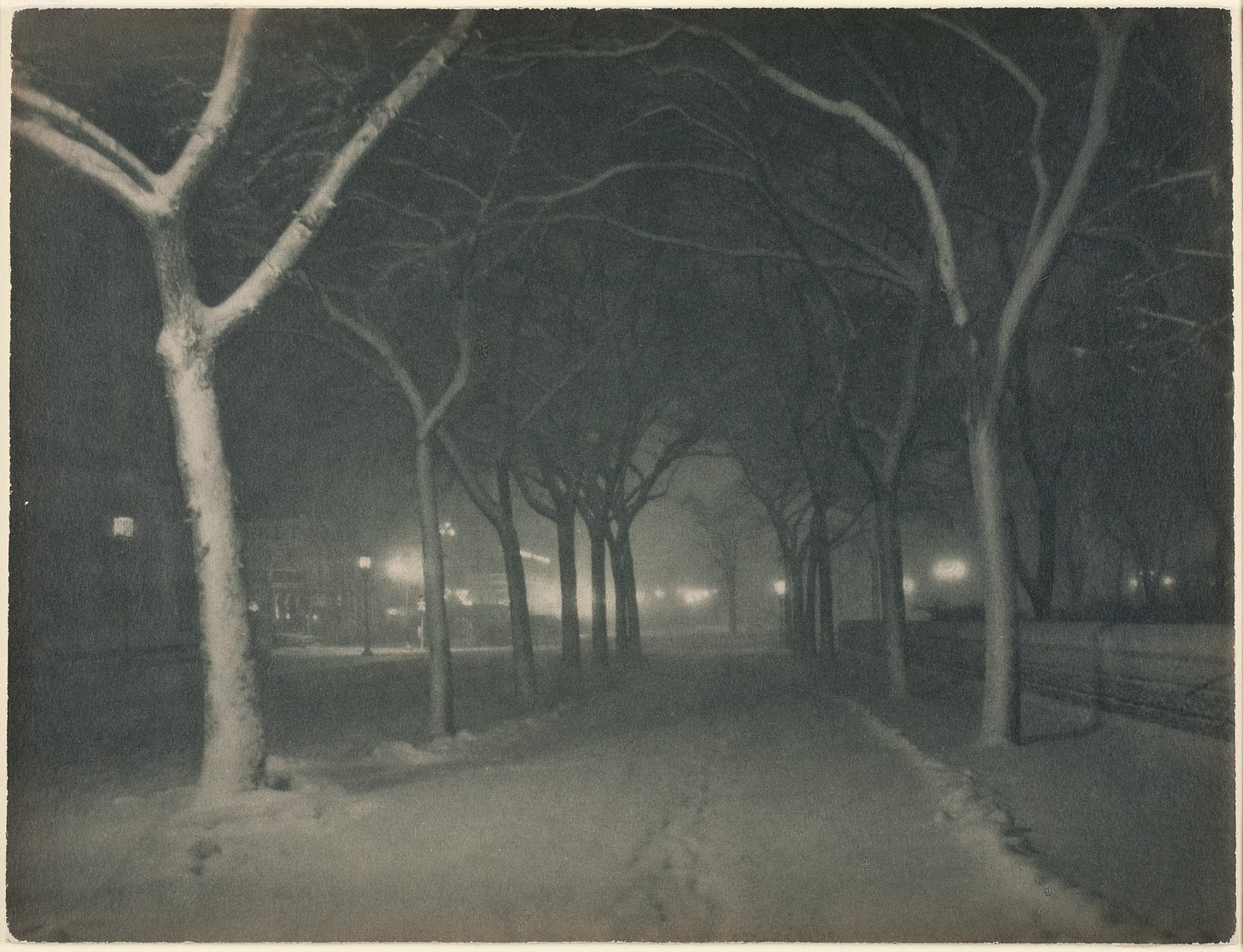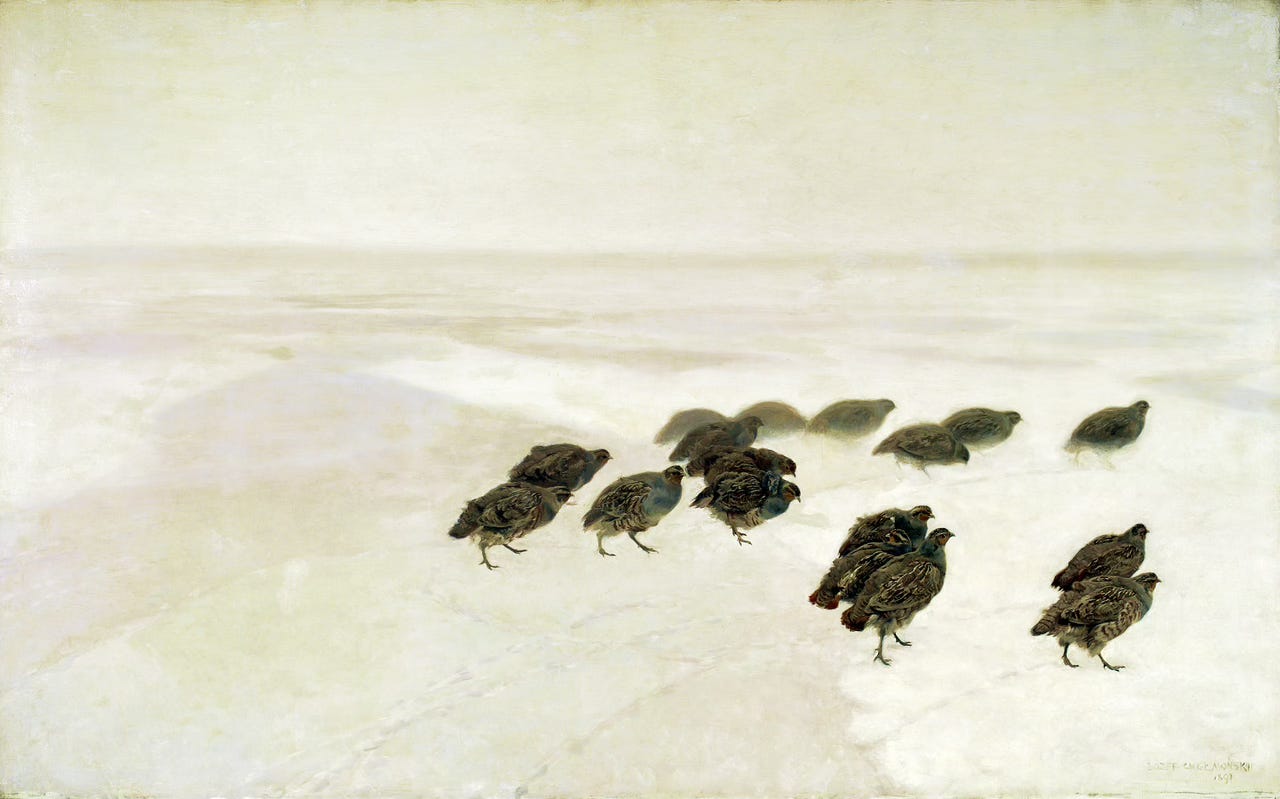I’ve always felt grateful that winter’s longest dark arrives separately from its deepest cold. Like difficult guests at a party, they’re easier to deal with one at a time. I wade home through the early sunset, muttering “solstice soon, solstice soon,” a mantra to keep one foot lifting after the other, to remind myself that—though the lengthy nights sap my energy, force me into a stillness like the bottom of an empty glass—the season’s light ratio tips early. Soon enough the sun will return, little by little, with each passing day.
Not so with the temperature. Here in Iowa, the coldest days come in January, plunging below zero as the wind keens over ice-crusted power lines and frost creeps across the windows. Those are the days when I leave the faucet dripping so the pipes don’t freeze, wear my wool hat to bed, rise to run the car in the middle of the night so it will start for me come morning.
By February I’m tired, a little numbed from the effort of such frigid hours, but at least spring is in sight.
You’d think dark and cold would arrive together, but put a pitcher of water in the freezer for five minutes, then take it out for five, in for four minutes, out for six, in for three minutes, out for seven—its temperature will be lower at the end than when you took it out the first time. Water, like the heart, freezes slowly, and the bitter days I battle in January result from the ground water beneath these hills finally turning crystalline. A few weeks after solstice, the days have been dark enough for long enough, that the ground has become cold enough for long enough, that the liquid flowing beneath the surface turns to ice. And ice it stays even as the sunlight grows, until finally the process reverses: the days are long enough to make the soil warm enough to bring the thaw.
It is not the moments of greatest hardship that make the heart go cold. Viktor Frankl describes the number of his fellow Auschwitz survivors that killed themselves after liberation: “We were not hoping for happiness—it was not that which gave us courage and gave meaning to our suffering, our sacrifices and our dying. And yet we were not prepared for unhappiness.” More soldiers commit suicide after returning home than at the front. At the front lives still the dream of family, the childhood house, the friend, the lover. At home dreams end. Only reality remains, in all its quotidian pain and boredom, its loss and disappointment. “Woe to him who found that the person whose memory alone had given him courage in the camp did not exist any more!” wrote Frankl, “Woe to him who, when the day of his dreams finally came, found it so different from all he had longed for.” Anyone striving after a single goal finds themselves disoriented upon arrival—what now—but when that striving has demanded so much blood and pain and terror, when the beacon of hope has become freighted with so much hurt, how could it ever be enough? The nights get shorter yet the mornings grow colder.
Often I forget this when caring for friends. One struggles toward the finish line of a pitiless graduate program. Another labors daily to care for a cruel, ailing mother. Both begin to whisper, quiet at first then louder, when will it end, please, let it end. When at last the end comes, they sigh and look to the horizon.
I exhale with them, relieved that the worst is now behind us. If I was wise, I would inhale—deep and slow—to steady myself for what lies ahead. The dark is past but cold awaits. As the days march on, the furious effort and perseverance both friends burned to make it this far stills into despondency. “What was it all for?” the first asks over long, chilly phone calls. “Why don’t you come over tonight,” I text the second. I know she’s been drinking too much alone.
It’s easy to lose patience, to wonder why, now that the fight is over, their spirits sink. But the human heart is fluid water and freezes slowly, bit by bit. For we the beloved, it’s time to stoke the fire and brew hot coffee, run the bath and bake fresh bread. Time to keep them warm while they find their next path, offer pleasure while the world echoes so much silence.
I shovel my driveway as the morning sun finally crests the rooftops, barely five hours before it will sink again behind them. The dark comes before the cold, and thank goodness. If they came at once, how could we get by? How could my friend slog through her last months of classes with this despair hanging over her? How could a daughter care for a dying woman of endless barbs? Maybe if we endured it all at once, spring would come faster. But I suspect for most of us, for me certainly, if dark and cold arrived together, we would not survive the solstices of our lives. Better to be grateful that water freezes slowly. We’ll hunker down and endure the snows.
Recommendations for winter reading:
For a beautiful book that captures the season in all its bitter, raw glory, read James Galvin’s The Meadow. A poet by trade, Galvin tells the true story of a single, alpine meadow on the Colorado-Wyoming border. He recounts the lives of its human inhabitants, the seasons, and the wildlife. The book has a cult following among writers, and for good reason.
For writing about the way weather shapes us, especially those of us from the Midwest, read Debra Marquart’s essay “Thirteen Ways of Looking at Weather.” Styled after Wallace Stevens’ poem “Thirteen Ways of Looking at a Blackbird,” Marquart’s essay unfolds in a series of anecdotes and meditations on how the weather molds our lives, cultures, and personalities. Also better known as a poet, Marquart has an incredible ability to make you feel the stinging cold, see the lightning, and smell the summer rain in her stories.
I promise I don’t only read Louise Glück’s poetry, but her collection The Faithful and Virtuous Night is quintessential winter vibes to me. Austere, hungry, drizzly, determined, the book taps into a mindset I need to make it through the darker months.







